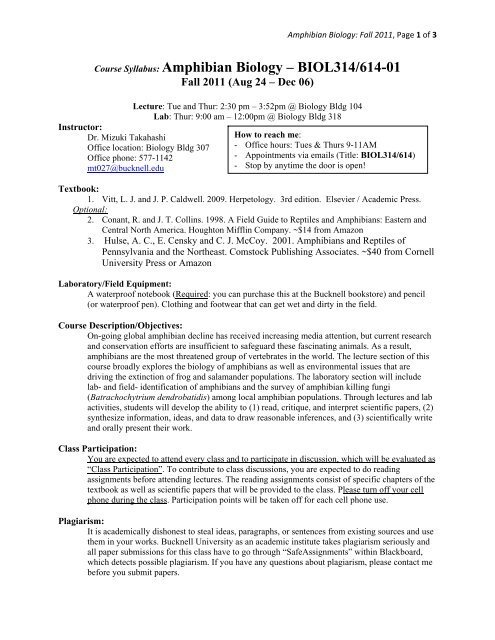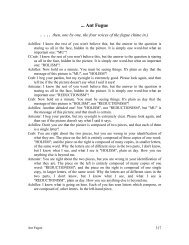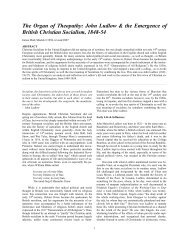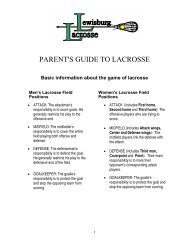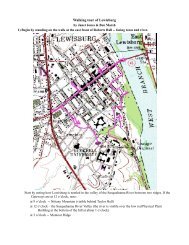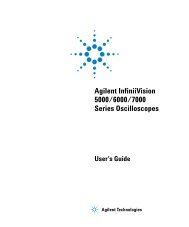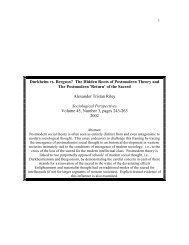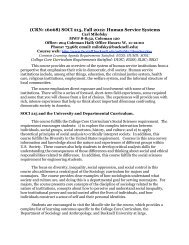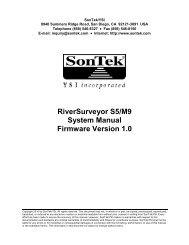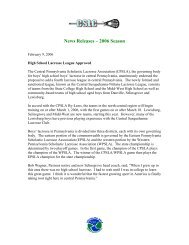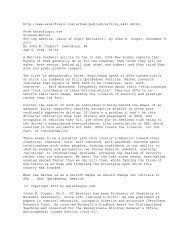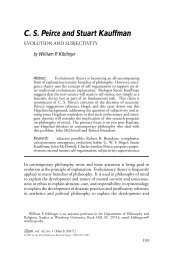the Fall 2011 course syllabus. - Bucknell University
the Fall 2011 course syllabus. - Bucknell University
the Fall 2011 course syllabus. - Bucknell University
You also want an ePaper? Increase the reach of your titles
YUMPU automatically turns print PDFs into web optimized ePapers that Google loves.
Amphibian Biology: <strong>Fall</strong> <strong>2011</strong>, Page 1 of 3<br />
Course Syllabus: Amphibian Biology – BIOL314/614-01<br />
<strong>Fall</strong> <strong>2011</strong> (Aug 24 – Dec 06)<br />
Lecture: Tue and Thur: 2:30 pm – 3:52pm @ Biology Bldg 104<br />
Lab: Thur: 9:00 am – 12:00pm @ Biology Bldg 318<br />
Instructor:<br />
Dr. Mizuki Takahashi<br />
Office location: Biology Bldg 307<br />
Office phone: 577-1142<br />
mt027@bucknell.edu<br />
How to reach me:<br />
- Office hours: Tues & Thurs 9-11AM<br />
- Appointments via emails (Title: BIOL314/614)<br />
- Stop by anytime <strong>the</strong> door is open!<br />
Textbook:<br />
1. Vitt, L. J. and J. P. Caldwell. 2009. Herpetology. 3rd edition. Elsevier / Academic Press.<br />
Optional:<br />
2. Conant, R. and J. T. Collins. 1998. A Field Guide to Reptiles and Amphibians: Eastern and<br />
Central North America. Houghton Mifflin Company. ~$14 from Amazon<br />
3. Hulse, A. C., E. Censky and C. J. McCoy. 2001. Amphibians and Reptiles of<br />
Pennsylvania and <strong>the</strong> Nor<strong>the</strong>ast. Comstock Publishing Associates. ~$40 from Cornell<br />
<strong>University</strong> Press or Amazon<br />
Laboratory/Field Equipment:<br />
A waterproof notebook (Required: you can purchase this at <strong>the</strong> <strong>Bucknell</strong> bookstore) and pencil<br />
(or waterproof pen). Clothing and footwear that can get wet and dirty in <strong>the</strong> field.<br />
Course Description/Objectives:<br />
On-going global amphibian decline has received increasing media attention, but current research<br />
and conservation efforts are insufficient to safeguard <strong>the</strong>se fascinating animals. As a result,<br />
amphibians are <strong>the</strong> most threatened group of vertebrates in <strong>the</strong> world. The lecture section of this<br />
<strong>course</strong> broadly explores <strong>the</strong> biology of amphibians as well as environmental issues that are<br />
driving <strong>the</strong> extinction of frog and salamander populations. The laboratory section will include<br />
lab- and field- identification of amphibians and <strong>the</strong> survey of amphibian killing fungi<br />
(Batrachochytrium dendrobatidis) among local amphibian populations. Through lectures and lab<br />
activities, students will develop <strong>the</strong> ability to (1) read, critique, and interpret scientific papers, (2)<br />
syn<strong>the</strong>size information, ideas, and data to draw reasonable inferences, and (3) scientifically write<br />
and orally present <strong>the</strong>ir work.<br />
Class Participation:<br />
You are expected to attend every class and to participate in discussion, which will be evaluated as<br />
“Class Participation”. To contribute to class discussions, you are expected to do reading<br />
assignments before attending lectures. The reading assignments consist of specific chapters of <strong>the</strong><br />
textbook as well as scientific papers that will be provided to <strong>the</strong> class. Please turn off your cell<br />
phone during <strong>the</strong> class. Participation points will be taken off for each cell phone use.<br />
Plagiarism:<br />
It is academically dishonest to steal ideas, paragraphs, or sentences from existing sources and use<br />
<strong>the</strong>m in your works. <strong>Bucknell</strong> <strong>University</strong> as an academic institute takes plagiarism seriously and<br />
all paper submissions for this class have to go through “SafeAssignments” within Blackboard,<br />
which detects possible plagiarism. If you have any questions about plagiarism, please contact me<br />
before you submit papers.
ASSIGNMENTS<br />
Please see “Assignment Guidelines” for more information<br />
Amphibian Biology: <strong>Fall</strong> <strong>2011</strong>, Page 2 of 3<br />
Examinations (individual):<br />
Following <strong>the</strong> <strong>syllabus</strong> schedule, <strong>the</strong>re will be two mid-term exams and a final comprehensive<br />
exam. Exam material will cover lecture, textbook information and in-class discussion. Students<br />
who arrive late will not have an extended exam period. Exams will not be given out after <strong>the</strong> first<br />
student leaves <strong>the</strong> room.<br />
Laboratory Research Paper and Presentations (group):<br />
The class will be divided into 4 groups of 3-4 students and each group will conduct an<br />
independent research project to test <strong>the</strong> prevalence of an amphibian killing fungus,<br />
Batrachocytrium dendrobatidis (Bd), in central Pennsylvania. Each group will focus on<br />
amphibians that occur in one of three habitat types: ponds, streams, and forests. Four field trips<br />
are scheduled to collect amphibian skin swabs. Students will extract Bd DNA, run PCR, and<br />
detect <strong>the</strong> presence or absence of Bd via electrophoreses. This project not only provides an<br />
excellent in-class research opportunity but also <strong>the</strong> possibility of a scientific publication if each<br />
group achives high-quality science. Detailed note-taking, careful practice of molecular techniques,<br />
appropriate data analyses and interpretation, and collaborations within and among groups are<br />
critical. Each group will present <strong>the</strong> final product both in an oral and written format (i.e., journal<br />
format) at <strong>the</strong> end of <strong>the</strong> semester.<br />
Laboratory Practical (individual):<br />
There is only one lab practical scheduled on November 17. Students will be evaluated on species<br />
identification and knowledge of habitats of amphibians that can be found in Pennsylvania.<br />
Local Pet Shop Assessment (group):<br />
Pet trade is one of <strong>the</strong> serious threats to <strong>the</strong> declining amphibian populations. The goal of this<br />
exercise is to understand <strong>the</strong> “legal” pet trade trend in this area of <strong>the</strong> United States. A group of<br />
students (3 or 4) will find, via phone or internet, a local pet store in central PA that sell ei<strong>the</strong>r<br />
amphibians or reptiles, visit <strong>the</strong> store, and collect data such as species, price, where <strong>the</strong>y come<br />
from, and staff’s knowledge about <strong>the</strong> amphibians and reptiles for sale. Each group ga<strong>the</strong>rs <strong>the</strong><br />
data into a 3-4 page report (single space). Each group will also present <strong>the</strong> data to <strong>the</strong> class.<br />
Guest Speaker Reports (individual):<br />
We are planning to have two guest speakers. In each visit, students will turn in 1-2 page<br />
reports (single space) summarizing <strong>the</strong> presentation and developing your discussion on <strong>the</strong><br />
presented issues (Due: <strong>the</strong> week following <strong>the</strong> guest speech).<br />
Student-led Discussions (individual):<br />
In-class discussion is an important element of this <strong>course</strong>, in which students will learn how to<br />
read, critique, and interpret scientific papers. Each student will pick a specific date at <strong>the</strong><br />
beginning of <strong>the</strong> semester. A student will find a scientific paper related to <strong>the</strong> topics covered by<br />
<strong>the</strong> lectures during <strong>the</strong> week of his/her presentation. The assigned student has to contact me about<br />
<strong>the</strong> paper at least a week before his/her discussion date. When <strong>the</strong> paper is approved by me, (s)he<br />
will send a PDF copy of <strong>the</strong> selected paper to <strong>the</strong> class at least three days before his/her<br />
discussion date. The discussion leader prepares at least three critical questions, and moderates and<br />
stimulates discussion. We will start discussion in a small group followed by a class discussion.
Amphibian Biology: <strong>Fall</strong> <strong>2011</strong>, Page 3 of 3<br />
Laboratory Notebooks (individual):<br />
Students are expected to record in detail all field and laboratory activities in a waterproof<br />
Rite in Rain notebook. This exercise is especially important for <strong>the</strong> development of a detailed<br />
method section of your manuscript. Instruction for proper journal entry format will be<br />
provided in <strong>the</strong> first laboratory session.<br />
Extra Points (individual):<br />
Although identification of frog calls is not a part of laboratory exercises, knowing frog calls<br />
makes spring much more enjoyable. Several frog calls will be played during <strong>the</strong> final<br />
laboratory practical. 0.5 extra point will be given to each correct answer.<br />
Grading:<br />
Final Exam (comprehensive) 80 pts (20%)<br />
Lab Research Paper and Oral Presentation 80 pts (20%)<br />
Lab practical 60 pts (15%)<br />
Exam I 40 pts (10%)<br />
Exam II 40 pts (10%)<br />
Local Pet Shop Assessment Paper and Oral Presentation 30 pts (7.5%)<br />
Class Participation 20 pts ( 5%)<br />
Guest Speaker report I 15 pts (3.75%)<br />
Guest Speaker report II 15 pts (3.75%)<br />
Discussion leading 10 pts (2.5%)<br />
Laboratory notebook 10 pts (2.5%)<br />
Total 400 pts (100%)<br />
A = 400 – 368 pts (100 – 92%)<br />
A- = 368 – 360 pts (92 – 90%)<br />
B+ = 360 – 352 pts (90 – 88%)<br />
B = 352 – 328 pts (88 – 82%)<br />
B- = 328 – 320 pts (82 – 80%)<br />
C+ = 320 – 312 pts (80 – 78%)<br />
C = 312 – 288 pts (78 – 72%)<br />
C- = 288 – 280 pts (72 – 70%)<br />
D = 280 – 240 pts (70 – 60%)<br />
*Grades may be curved depending on <strong>the</strong> class performance.


